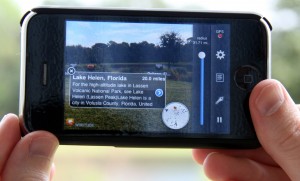Learn more
- Oct 6, 2010
Marrying ARML with Linked Data
First of all, since ARML (augmented reality markup language) is based on KML and KML uses „Placemarks“ (which all have corresponding identifiers) as basic entities, these could be identified quite easily via URIs within the W3C Resource Description Framework (RDF).
Another basic concept of KML is „Point“. Geo RDF provides properties like „geo:long“ or „geo:lat“ which express longitude and latitude of a POI and thus makes it possible to uniquely identify certain points on a map using RDF standards.
Thus it is possible to map the geo conventions of ARML to the geo conventions of the Semantic Web which are mainly based on Geo RDF.
As soon as a placemark has received a URI it is also possible to expose it as linked data and interlink it with repositories like Geonames, DBpedia or LinkedGeoData (which is based on Open Street Map) to generate Linked Geodata.
ARML makes it possible to link / make a relation between a „Provider“ and a „Placemark“. Thus it is also possible to use a URI to describe a provider and link it to a placemark using the typical triple-struture imminent to RDF.
OpenARML/Wikitude uses tags to describe certain things. These tags are currently represented as literals (strings), seperated by commas. This poses that obstacle that these tags can hardly be processed by machines. With RDF each tag would be assigned a URI, thus changing it from a literal to a resource, which further can be represented in SKOS/RDF, another Semantic Web specification of the W3C.
ARML/Wikitude also offers attributes to describe POIs like phone, URL, email, attachment etc. which all of them could be represented by Semantic Web defacto standards like FOAF, SIOC etc.
Summing up, ARML/Wikitude documents could relatively easily be transformed in valid RDF / Linked Data Graphs. This could help to enrich AR-applications with data from the LOD (Linked Open Data) cloud. Vice versa data generated by ARML applications could be exposed as Linked Data.
As a pragmatic approach we recommend to generate on top of existing Wikipedia URLs the corresponding DBpedia URIs which would directly transform ARML placemarks into a resource as part of the existing LOD cloud.
As soon as placemarks are mapped to DBpedia additional metadata could be added to a placemark which opens up totally new perspectives on content enrichment in ARML environments enabling new and exciting AR-applications.
We want to thank Martin Lechner from Salzburg based Mobilizy for a fruitful discussion we had so far on this topic.
BTW: check out the paper by Reynolds et al. (2010) from DERI on “Exploiting Linked Open Data for Mobile Augmented Reality“
